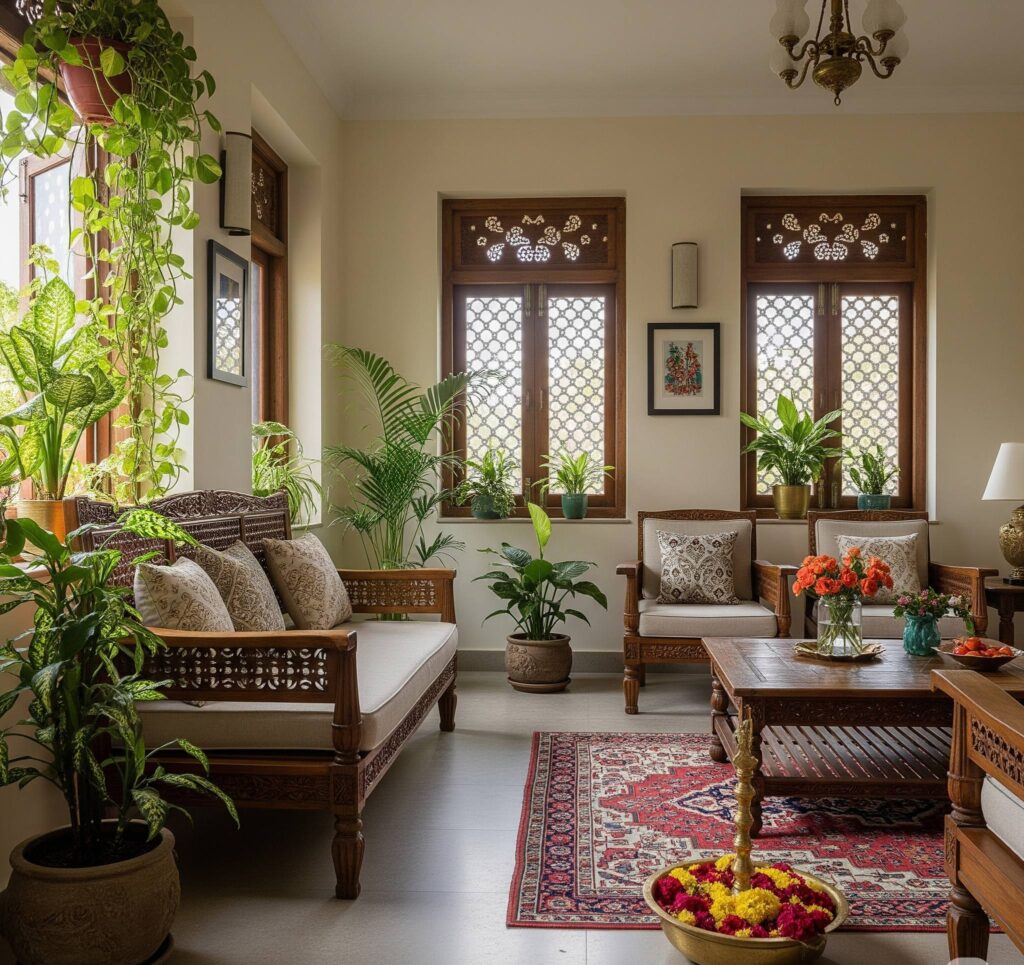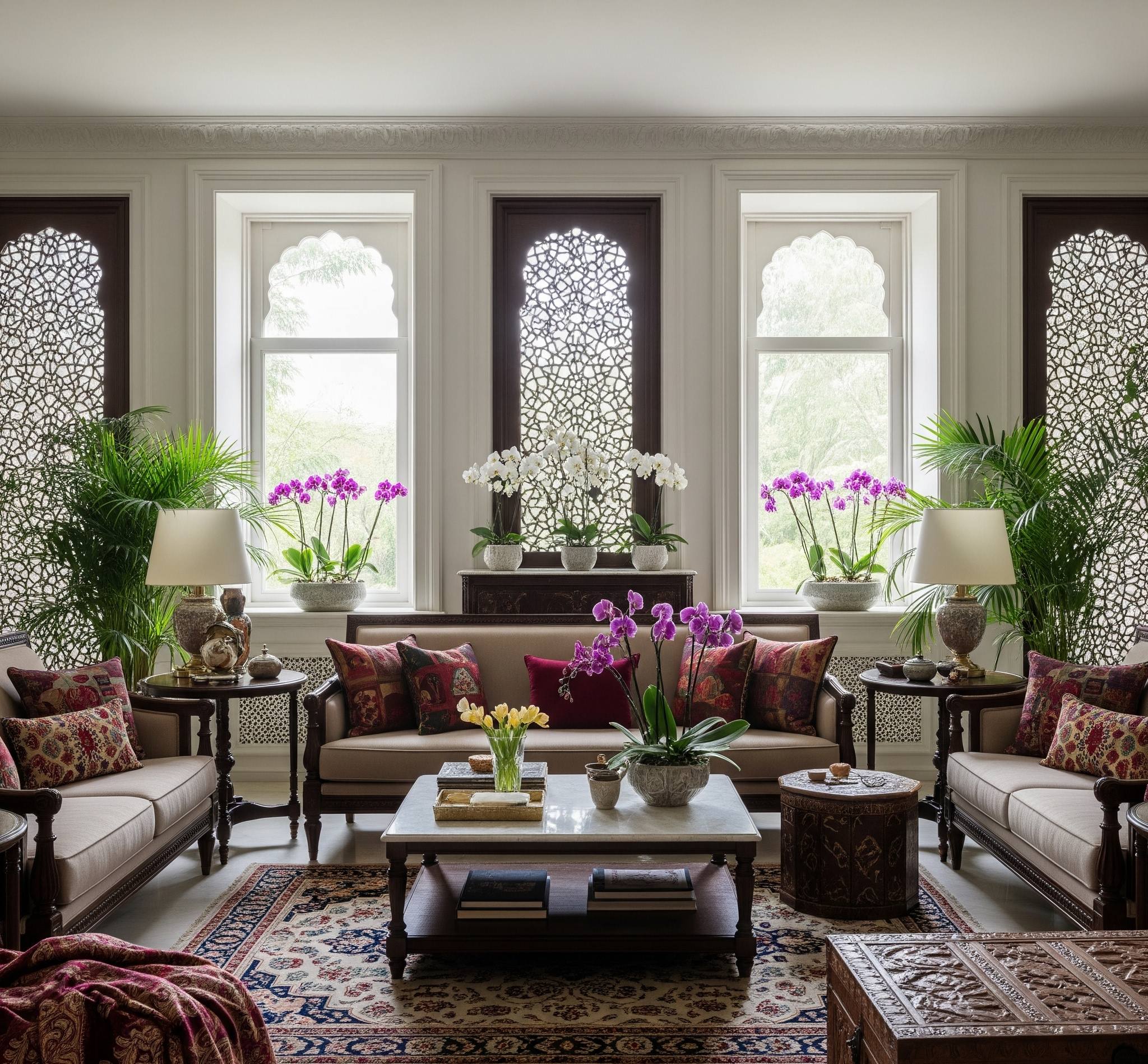
Table of Contents
Biophilic design in modern homes
Imagine stepping into your home after a long day and instantly feeling a wave of calm wash over you. The air feels fresher, the light is soothing, and a sense of natural tranquility permeates every corner. This isn’t just a dream; it’s the profound impact of biophilic design in modern homes , an increasingly popular trend that’s transforming modern Indian homes.
At A1 Interiors, we’re passionate about creating spaces that don’t just look good but genuinely make you feel good. That’s why we’re seeing a significant surge in interest in biophilic interior design – an approach that seamlessly weaves elements of nature into our living and working environments. In an age of rapid urbanization, bringing the outdoors in isn’t just a luxury; it’s a necessity for our well-being. This blog post will explore what biophilic design is, why it’s a perfect fit for India, and how you can integrate it into your own sanctuary.
What is Biophilic Design?
At its heart, biophilic design is about connecting humans with nature within built environments. The term “biophilia” literally means “love of life or living systems.” In interior design, it translates into a philosophy that incorporates natural elements, patterns, and processes into a space to foster a deeper, innate connection with the natural world.
It’s more than just adding a few potted plants. Biophilic design principles encompass a holistic approach, including:
- Direct Nature: Introducing actual natural elements like plants, water features, natural light, and fresh air.
- Indirect Nature: Using natural materials, colors, textures, and patterns that mimic nature (e.g., wood grains, stone patterns, organic shapes).
- Space and Place: Designing spaces that evoke a sense of freedom, prospect, refuge, and connection to the larger ecosystem.
This design philosophy is gaining immense traction globally, and particularly in India, due to its tangible benefits. As urban landscapes expand and our lives become increasingly digital, there’s a collective yearning for the calm and restorative power of nature. Wellness interior design is no longer just a buzzword; it’s a fundamental requirement. By integrating nature, biophilic design effectively addresses issues like stress reduction home design, improving air quality, and fostering overall mental and physical well-being.
Why Biophilic Design is Perfect for Indian Homes
India has always had an intrinsic connection with nature, deeply rooted in its culture, traditions, and even its ancient architectural practices. This makes biophilic design in modern homes a natural and harmonious fit for our homes.
- A Nod to Tradition: Historically, traditional Indian architecture seamlessly integrated courtyards, open-to-sky spaces, water bodies, and natural ventilation systems (like jali work) to create comfortable and climate-responsive homes. Biophilic design merely reinterprets these timeless principles for the modern context, ensuring our green interiors honor our heritage.
- Climate Compatibility: India’s diverse climate, particularly the tropical and subtropical regions, is highly conducive to indoor plants for Indian homes and maximizing natural light. Unlike colder climates where indoor greenery might struggle, many native and common houseplants thrive in our conditions, making integration easier and more sustainable.
- Cultural & Spiritual Resonance: From Tulsi plants in courtyards to the spiritual significance of trees and rivers, nature holds a revered place in Indian culture. Biophilic design taps into this deep-seated appreciation for the environment, fostering healthy homes that resonate with our spiritual and emotional needs.
- Urban Greening Imperative: With rapid urbanization, city dwellers often feel disconnected from green spaces. Urban greening through biophilic design offers a vital antidote, transforming concrete jungles into calming personal havens, improving mental peace and physical health.
Key Elements of Biophilic Design in India and Biophilic design in modern homes Interiors

Biophilic design in modern homes
So, how can we bring these principles to life in your Indian home? Here are the core elements we focus on:
1. Lush Indoor Plants & Greenery
Plants are the most direct and impactful way to incorporate nature. Consider varieties that thrive in India’s climate and complement indoor aesthetics:
- Air Purifiers: Snake Plant (Sansevieria), Peace Lily, Areca Palm, ZZ Plant.
- Easy Care: Money Plant (Pothos), Spider Plant, Fiddle Leaf Fig (for larger statements).
- Creative Placement:
- Vertical Gardens: Ideal for compact apartments, transforming a bare wall into a living art piece.
- Terrariums & Kokedama: Miniature ecosystems that bring a delicate touch of nature.
- Large Potted Plants: Grouped in corners or used as natural room dividers.
- Hanging Planters: Cascading greenery from ceilings or shelves.
2. Embrace Natural Materials
Moving away from synthetic finishes, natural materials interior design is crucial for biophilia. These materials not only look beautiful but also connect us to the earth’s raw textures and authenticity.
- Wood: Reclaimed teak, mango wood, or sheesham for furniture, wall panels, or flooring.
- Stone: Polished or rough-hewn natural stone (like Kota, Kadapa, or local granite) for flooring, countertops, or accent walls.
- Clay & Terracotta: Incorporate terracotta tiles, pottery, or wall finishes for an earthy, cooling effect.
- Fibers: Jute rugs, bamboo furniture, wicker lampshades, and linen curtains add organic texture and warmth.
- Metals: Subtle use of brass or copper accents can reflect light naturally.
3. Maximize Natural Light & Airflow
The sun and breeze are powerful natural healers. Designing for optimal light and ventilation is key to biophilic design in modern homes interior design.
- Large Windows & Doors: Prioritize expansive openings to allow maximum natural light penetration.
- Sheer Curtains: Use light, translucent fabrics to filter harsh glare while maintaining brightness.
- Cross-Ventilation: Strategically place windows and vents to facilitate airflow, reducing reliance on artificial cooling.
- Jali Work: Reinterpret traditional jali (perforated screens) for partitions, window coverings, or accent walls. They filter light beautifully, create intricate patterns, and allow air to circulate.
- Open Layouts: Design spaces that flow freely, allowing light and air to move unhindered.
4. Incorporate Soothing Water Features
The sight and sound of water are inherently calming. Even small additions can make a big difference.
- Indoor Fountains: A small, aesthetically pleasing indoor fountain can add a gentle trickling sound and a meditative focal point.
- Aquariums: A well-maintained aquarium provides a mesmerizing visual of aquatic life.
- Water Walls: For larger spaces, a subtle water wall can create a serene backdrop.
5. Choose Earthy Colors & Organic Textures
The color palette should reflect nature’s tranquility.
- Earthy Tones: Dominant use of greens (moss, olive, sage), blues (sky, ocean), warm browns, beiges, and terracotta hues.
- Organic Textures: Combine rough stone with smooth wood, soft linen with textured jute, and varied plant foliage to create tactile richness that stimulates the senses.
6. Frame Views & Foster Outdoor Connection
Create visual bridges between your indoors and the world outside.
- Strategically Placed Seating: Position seating areas to face windows with compelling views of trees, gardens, or the sky.
- Balcony Gardens: Transform balconies into extensions of your living space with lush plants and comfortable seating, blurring the line between inside and out.
- Courtyards: For homes with central courtyards, design them as accessible, green oases that are visible from multiple rooms.
Benefits Beyond Aesthetics
The beauty of biophilic design in modern homes extends far beyond its visual appeal. It offers concrete advantages that contribute to a healthier, happier life:
- Improved Well-being & Mental Health: Exposure to natural elements has been shown to reduce anxiety, alleviate stress, and boost mood. Our homes become true sanctuaries.
- Enhanced Productivity & Creativity: Studies suggest that environments with biophilic elements can improve cognitive function, focus, and creativity, making your home office more inspiring.
- Better Air Quality: Indoor plants naturally filter toxins and produce oxygen, leading to cleaner, fresher air within your living spaces.
- Reduced Stress Levels: The calming presence of nature fosters relaxation and can significantly lower stress and blood pressure.
- Increased Property Value: While subjective, homes designed with a strong connection to nature, good ventilation, and natural light are increasingly desirable, subtly enhancing their market appeal.
Best interiors company who design Biophilic design in modern homes find more in your city
Tips from Our Experts at A1 Interiors
At A1 Interiors, our interior designers are adept at seamlessly integrating biophilic design in modern homes into diverse Indian architectural styles. Here are a couple of insights from our team:
- Start Small, Think Big: You don’t need a complete overhaul. Begin by introducing a few key elements like a prominent indoor plant or a strategically placed mirror to reflect outdoor views. We can then work with you to gradually expand these concepts into a full green interiors transformation.
- Embrace Local Craftsmanship: India boasts a rich heritage of natural materials and artisanal skills. We often incorporate custom-made terracotta planters, hand-carved wooden accents, or locally sourced stone features to give your biophilic space a truly unique and authentic Indian touch, supporting local artisans while achieving a sustainable interior design India vision.
Conclusion
Biophilic design in modern homes in India is more than just a passing trend; it’s a mindful evolution in how we approach living spaces. It’s about recognizing our innate need for nature and consciously integrating it into our homes to create environments that are not only beautiful but also deeply nurturing. By embracing this philosophy, you can transform your home into a harmonious oasis, a haven of healthy homes that promotes peace, productivity, and profound well-being.
Ready to infuse your living space with the calming power of nature?
Contact A1 Interiors for a consultation on incorporating biophilic design into your home. Let’s create your personal green sanctuary.
Biophilic design in modern homes in Karnataka , Biophilic design in modern homes in Bangalore, Biophilic design in modern homes , Mysore, Tumakuru,Shivamoga, Hassan, Chikamagalur.
